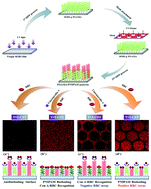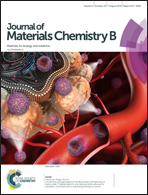Multiple microarrays of non-adherent cells on a single 3D stimuli-responsive binary polymer-brush pattern†
Abstract
We have developed a 3D smart binary polymer-brush pattern on the polymer substrate for inducing multiple cell microarrays aided by a lectin and temperature. The binary polymer-brush pattern composed of poly(N-isopropylacrylamide) (PNIPAM) and poly(D-gluconamidoethyl methacrylate) (PGAMA) brushes is fabricated by combining the photolithography technique with a surface-initiated photo-polymerization (SIPP) method. We demonstrate that well-defined binary polymer-brush patterns with high resolution are fabricated using this facile method. The patterned hierarchical PNIPAM brushes exhibit reversible switching to the adhesion of red blood cells (RBCs) induced by thermo-responsiveness. The PGAMA brush domains resist adhesion of RBCs but bind specifically with concanavalin A (Con A), forming a lectin pattern to capture RBCs in a site-specific manner. Therefore, multiple cell microarrays on a single platform are generated with the aid of Con A and temperature. This novel platform composed of a smart binary polymer-brush pattern is versatile and specific, which opens up pathways to potential applications such as microsensors, biochips and bioassays.



 Please wait while we load your content...
Please wait while we load your content...